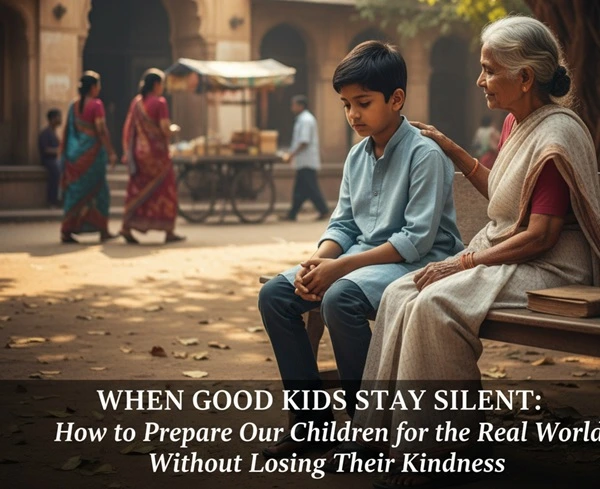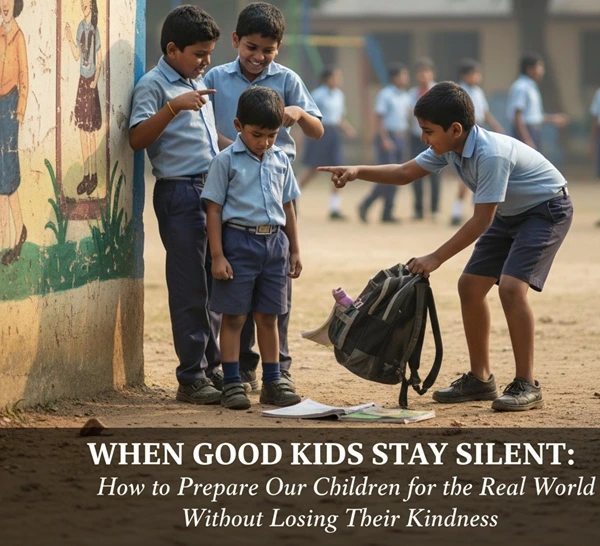A Parent’s Heartfelt Concern
As a parent, there’s no greater joy than hearing teachers praise your child — “He’s so sincere, obedient and soft-spoken.” Those words melt your heart and make you proud. My child is exactly like that — disciplined, caring and always ready to help others. He excels in academics, respects everyone and carries an innocence that makes him loved by teachers and admired by many.
But as parents, sometimes we notice something deeper — a silence that speaks volumes. When other kids tease him or when someone tries to take advantage of his goodness, he doesn’t respond, he stays quiet, he believes walking away is better than fighting back.
And that’s where our worry begins — how do we raise a kind child who can also stand up for himself in a world that’s not always kind?

Understanding the Root of the Problem
Children who are empathetic, gentle and obedient often avoid conflict. They want to maintain peace at all costs. But this sometimes makes them easy targets for bullies or dominant peers.
Research published by the American Psychological Association shows that bullies often pick on children who are less likely to retaliate, not because they are weak, but because they prioritize harmony and emotional balance.
As parents, it’s not about changing who they are — it’s about equipping them emotionally, mentally and socially to handle the real world while preserving their core goodness.
Why Kind Kids Stay Silent
There are many reasons why a child may not respond when bullied or teased:
- Fear of Conflict: They may feel any response will escalate the situation.
- Overemphasis on “Being Good”: We often tell kids to “ignore”, “walk away” or “don’t talk back.” While these values build discipline, they can also discourage self-expression.
- Low Social Confidence: Academically strong kids may struggle in social situations, fearing rejection or embarrassment.
- Empathy Over Self-Defense: They think standing up for themselves might hurt others’ feelings.
Understanding this helps us address the root — not just the behavior, but the mindset.
Step 1: Redefine What It Means to Be ‘Good’
Many children equate goodness with silence. We, as parents, need to change that narrative.
Being “good” doesn’t mean being silent in the face of disrespect.
Teach your child that kindness and assertiveness can coexist.
You can say things like:
- “You can be respectful and still stand up for yourself.”
- “It’s okay to say no when something feels wrong.”
- “Walking away is fine, but never let someone make you feel small.”
This helps them understand that self-respect is part of being a good human.
Step 2: Build Emotional Intelligence
Help your child recognize emotions — both theirs and others’.
Discuss situations openly:
- “How did you feel when he said that?”
- “What do you think you could have said instead?”
Role-play common scenarios of teasing or peer pressure. Practice calm but firm responses like:
- “That’s not funny.”
- “I don’t like it when you say that.”
- “Please stop.”
According to Harvard’s Center on the Developing Child, emotional intelligence plays a key role in resilience — the ability to bounce back from challenging situations without losing empathy.
Step 3: Boost Confidence Beyond Academics
Academics are important, but confidence grows from varied experiences. Encourage your child to participate in:
- Group activities like sports or theater, which help develop team dynamics and leadership.
- Debates, storytelling or public speaking, to build communication strength.
- Hobbies that promote independence, such as painting, coding, or volunteering.
When children experience small wins outside the classroom, they begin to feel more capable and confident in social settings.
Step 4: Teach Boundaries Early
Boundaries aren’t rude — they’re healthy.
Children should learn it’s okay to say “no,” even to friends.
Discuss real-life examples:
- “If someone teases you, what can you say instead of staying quiet?”
- “If someone takes your things without asking, how will you respond?”
Encouraging assertive but respectful communication helps kids handle tricky peer dynamics confidently.
Step 5: Lead by Example
Children watch us closely. The way we handle criticism, disagreement or confrontation becomes their blueprint.
If they see us dealing with unfair situations calmly but firmly, they’ll learn to mirror that behavior.
For example:
If a neighbor behaves rudely, instead of ignoring it completely, respond politely but assertively in front of your child. Later, explain why that response was important.
Your actions will silently teach them the balance between grace and strength.
Step 6: Teach Them About the Real World
Explain, gently but truthfully, that not everyone will be kind.
The world has both compassionate and cruel people — and they need to learn to navigate both.
Tell them stories — real or fictional — where good people stood up for themselves without being aggressive.
Examples like:
- Mahatma Gandhi, who practiced non-violence yet never accepted injustice.
- Malala Yousafzai, who spoke up for girls’ education despite fear.
Such stories help children understand that speaking up doesn’t mean being rude — it means being courageous.
Step 7: Work with Teachers and Counselors
If your child faces bullying at school, talk to teachers or the school counselor.
Many schools now conduct social-emotional learning programs that teach empathy, conflict resolution and communication skills.
Ensure your child knows that speaking to a trusted adult isn’t a sign of weakness — it’s a responsible step.
Step 8: Strengthen the Home Environment
A child who feels emotionally safe at home is more likely to express themselves outside.
Create an open environment where your child can share anything without fear of judgment.
Instead of saying, “Why didn’t you say something?” try,
“I understand that must have been tough. Let’s think together about what you could do next time.”
This approach turns mistakes into learning experiences rather than guilt-driven moments.
Step 9: Encourage Mindfulness and Inner Strength
Activities like yoga, journaling or meditation can help sensitive kids develop emotional clarity.
It allows them to pause, breathe and think before reacting — giving them confidence in managing emotions rather than suppressing them.
Mindfulness also builds self-worth, which is the strongest defense against bullying.
Step 10: Remind Them – Kindness Is Still Power
At the end of the day, never make your child feel that being good is wrong.
The world needs more kind, empathetic humans — but they must be strong enough to protect their kindness.
Remind them:
“You can be gentle, but never be a doormat.
You can be polite, but still be powerful.
You can be kind, and still be brave.”
Conclusion: Raising Strong Hearts in a Tough World
Parenting a good-hearted child in today’s fast-paced, competitive world can feel like walking a tightrope.
We want them to stay humble, yet bold and gentle, yet strong.
The goal isn’t to make them aggressive — it’s to help them balance compassion with confidence.
Because a child who knows their worth will never need to shout — their quiet strength will speak for itself.
Let’s raise children who shine with both kindness and courage — ready to face the world without losing their beautiful hearts.
For more Parenting Tips, Follow Popnewsblend.com

Hi, I’m Prashant Jain — a curious soul, storyteller, and content creator at heart.I’ve always been drawn to the world of entertainment, travel, sports, health & lifestyle — not just as a writer, but as someone who genuinely lives these experiences. Whether I’m binge-watching the latest OTT series, exploring offbeat spiritual destinations in India, or diving deep into wellness routines and cricket match insights, I love sharing what I discover with like-minded readers.
PopNewsBlend is my way of blending personal journeys with meaningful stories — ones that inform, inspire, and keep you ahead of the curve. Everything I write comes from real observations, hands-on experiences, and a deep passion for understanding the world around us.
Discover more from Popnewsblend
Subscribe to get the latest posts sent to your email.







